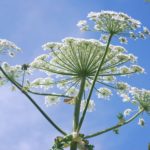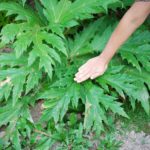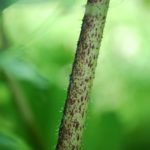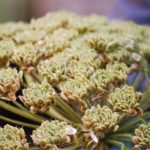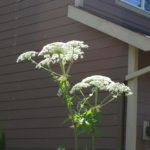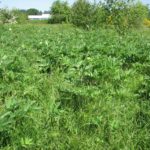Gallery:
- Giant hogweed flower head
- Giant hogweed leaf with hand for perspective
- Giant hogweed stem
- Giant hogweed seed head
- Giant hogweed
- Giant hogweed infestation
Common names:
Giant hogweed, giant cow parsley, giant cow parsnip, wild parsnip, cartwheel flower
Scientific Name:
Heracleum mantegazzianum
Description:
Giant hogweed is a distinctively large, escaped ornamental in the Apiaceae (carrot) family. The hollow stems have reddish-purple spots, are covered with bristles, and are 2 – 4 inches wide. The leaves are sharply and deeply cut and can be 5 feet wide, while the white flowers grow in flat-topped clusters that can be 3 feet wide.The plant spreads by seed, producing anywhere from 5000 to 100,000 seeds per plant. It takes 3-5 years to produce flowers, and is monocarpic, which means the plant dies after it flowers.
Life cycle:
Height of mature plants
15-20 feet tall
Flower color:
white
Bloom time:
Mid-May to July
Look-a-likes:
Giant hogweed looks extremely similar to the native cow parsnip. When mature, giant hogweed is larger than the native cow parsnip that only grows 6 feet tall with flower heads that are 8-12 inches. However, before maturity, the distingishng features are subtle and relative to each other: the purple spots on giant hogweed are more raised, the hairs on the leaf underside are shorter, and the leaves are more deeply cut.
Habitat:
Giant hogweed is somewhat shade tolerant and prefers moist soils. However, it is also grows well in full sun. Escaping cultivation by seed, this plant can be found in backyards, grasslands, ravines, parks, vacant lots, streamsides, woodlands, and roadsides.
Impacts:
Giant hogweed has a clear sap that is photo-toxic, which means skin contact followed by sun exposure can cause severe, painful blisters that can leave dark scars (contact with the smoke from burning the plant has similar effects). It is a prolific seeder, and the seeds can float in water up to 8 hours. Furthermore, it can out-compete native plants and invade stream areas.
Noxious Weed Listing:
- WeedWise: priority
- State of Oregon: Class A, T
- State of Washington: Class A
- Four County CWMA: Class A
- Columbia Gorge CWMA: Class A
Origin:
Caucasus Mountains and southwestern Asia
Links:
Oregon Noxious Weed Profile
Washington Noxious Weed Profile
King County Noxious Weed profile
CABI Invasive Species Compendium

